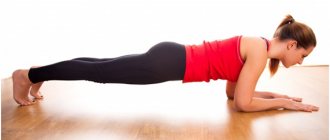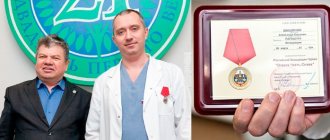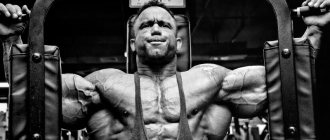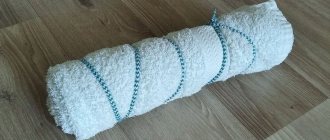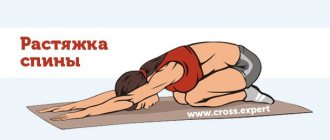Share:
What you need
- Dumbbells
- Barbell
- Exercise equipment
Beautiful and voluminous shoulders are an attractive appearance for both an athlete and an ordinary person. Developed shoulders bring the body shape closer to a V-shape, making the figure more athletic.
Let's look at some basic shoulder exercises that will help you achieve a powerful upper body and will be an excellent incentive for further muscle gain.
How to organize training correctly?
The decision to pump up your shoulders does not arise out of nowhere. Either someone persistently recommended this to you, or in the process of working on yourself you felt that not everything was okay with this zone. In the first case, the most logical option is to start going to the gym. And you will definitely need a trainer who will assess your initial condition, set priorities and recommend a course of effective shoulder exercises.
If you are not new to sports, an instructor is not necessary: you will be able to develop a training plan yourself. It doesn’t matter where you train – in the gym or at home. The main thing is to have access to the necessary athletic equipment.
And don't forget the three principles of effective training:
- regularity;
- continuity;
- progressiveness.
In other words, classes need structure. Let the interval between training days be long but stable. The training process itself must be continuous. If you have allocated 1 hour for yourself, then you cannot take unplanned breaks during it. It is important to gradually increase the load, but at the same time maintain proper technique.
Treatment of lumbar scoliosis
The basis of scoliosis treatment is therapeutic exercises. All exercise therapy is focused on spinal traction, self-traction (using your own weight) and hardware traction (on special tables or couches). In addition to spinal traction, the treatment of scoliosis includes strengthening the muscular frame of the back and abdomen. Stretching the muscles is also important.
Exercise therapy for scoliosis, the benefits of exercise
If you want to learn in more detail how to cure scoliosis at home and consider a set of effective exercises, you can read an article about this on our portal.
Yoga in the treatment of lumbar scoliosis
There is a recommendation from the National Scoliosis Foundation of the United States of America, which identifies a number of asanas as suitable for the treatment of scoliotic phenomena in the body. Even a beginner can cope with their implementation.
Shoulder anatomy
The shoulder muscle is otherwise called the “delta” for its similarity to the triangular shape of the Latin letter of the same name. The biceps and triceps are located lower and do not belong to the deltoid muscle. Therefore, an athlete doing shoulder exercises must understand that as a result, only his upper arms will be pumped up, but not his arms themselves. It is for this reason that delt exercises are suitable for girls who want to have relatively broad shoulders, but do not want to be too muscular.
The deltoid muscle is attached to three bones: the humerus, scapula and clavicle. When performing exercises, take into account the individual characteristics of the body. If you have had fractures or dislocations of the listed bones, it is recommended to exercise only with a trainer, and loads should be limited. A similar requirement applies to injuries of the shoulder joints or their ligaments.
The delta consists of three bundles: anterior, middle (lateral) and posterior. Let's look at their location and participation in training in more detail in the table.
| Delta muscle bundles | Anatomy | Work in exercises |
| Front | Covers the shoulder joint from the front | Shoulder flexion and internal rotation, raising arms in front of you |
| Average | Covers the shoulder joint from above and from the side | Lateral shoulder abduction |
| Rear | Attached to the humerus from the upper back | Horizontal extension and external rotation of the shoulder |
© Alila Medical Media — stock.adobe.com
The two main functions of the delta are to push the load away from you and to pull it towards you. These two components give rise to all the variety of movements that we use in shoulder exercises. When we do front swings, dumbbell and barbell presses, we develop the pushing function (front beam). Swings from the sides or in an inclined position, as well as all kinds of traction, are the second component (middle and rear beams).
For the full development of deltas, you need to perform at least one exercise for each of the beams. Most often, athletes “fall out” of the back and middle ones, since the front one is quite easy to pump up thanks to its participation in all presses, and exercises for the other two beams are either neglected, or not done enough, or with the wrong technique (for example, swinging heavy dumbbells with cheating) .
Biceps stretch
Stretching the biceps is one of the important factors in the growth of this muscle. By stretching, the biceps stops shortening and losing flexibility. By improving blood supply, biceps recovery occurs 15–25% faster.
Here are a few techniques to help stretch this muscle:
- To perform the first exercise, you need to stand up straight, place your feet shoulder-width apart, clasp your hands behind your back so that your palms are pointing down. In this position, raise your arms straight up without bending your body. Try to feel the stretch in your biceps.
- Stand with your back to the door frame or horizontal bar post. Reach one arm back and grasp the doorframe with your hand so that your thumb is pointing up. Now try to turn your arm around its axis with the biceps down, while the hand should not turn around. Complete this exercise for both hands and move on to the next one.
- For this exercise you will need a horizontal bar. Simply hang from the horizontal bar using a supinated (reverse) grip. Hang by arms outstretched for as long as you can.
Warm-up
Warm-up is a very important step before every workout. In this case, it is necessary to warm up the shoulders and minimize injuries. For 5-10 minutes, perform simple warm-up exercises in the starting position - standing on the floor:
- Tilt your head in different directions and rotate in a circle.
- Circular rotation of the shoulders forward and backward.
- Alternately raising your arms up through the sides and lowering them.
- Horizontal swings of arms.
- Again, circular rotations with your arms back and forth. Then one hand forward and the other back. Change hands.
Shoulder injuries are one of the most common, so pay due attention to the warm-up and do it as thoroughly as possible.
Training plan
To effectively pump your shoulders at home, you need a training program. We offer an example of such a program:
- Warm-up: swing rotations in the shoulder and elbow joints.
- Pull-ups on the horizontal bar (3-4/10-15).
- Corner push-ups (3-4/12-15).
- Military press (3-4/12-15).
- Bent-over dumbbell flyes (3-4/12-15).
- Elevated push-ups (3 sets to failure).
- If you're only training your shoulders, you can do this workout plan 2-3 times a week. Be sure to leave a rest day between classes.
- If you are working out your whole body and doing it on a split basis, we recommend combining the proposed program with training your back or legs.
The training plan is designed for 6-8 weeks. Then it needs to be changed.
Basic exercises
We bring to your attention several of the most effective basic shoulder exercises so that you can choose the most suitable ones for yourself. It is better to do the first few workouts with an instructor so that he can control you, explain and show you the technique.
Also, do not forget about isolation exercises - most movements for the middle and posterior bundles are exactly like this, but this does not mean that they are ineffective. You just need to competently combine base and isolation depending on your goals, length of service and training experience.
Barbell chest press standing and sitting
The standing chest press is also called the military press. This is the most effective exercise for developing the pushing function of the deltoid muscle.
And that's why:
- Free weight exercises work a lot of stabilizer muscles.
- Large range of motion: you can touch the barbell to your chest, you can lower it to your chin if you feel uncomfortable doing it too low.
- The exercise can be done by any person, not just weightlifters. It is enough to choose a comfortable weight.
Advice! The grip on the bar for this exercise should not be too wide or too narrow. Optimal option: slightly wider than shoulder width. The forearms in the starting position should be perpendicular to the floor. When lifting the barbell, do not follow it with your eyes. Don't extend your elbows all the way - this is true for all shoulder presses.
The exercise can also be done while sitting:
© Makatserchyk — stock.adobe.com
Many people think that this will reduce the load on the spine, but in fact the opposite is true - the load on the intervertebral discs in this movement will be greater in a sitting position. And if for small weights there is not much difference, and you can start doing the exercise while sitting, and then switch to the standing version, which is more difficult in terms of technique, then with large weights you should definitely work only in a standing position.
Another option is to sit in Smith. Here the movement will be strictly specified by the design of the simulator, which “turns off” some of the stabilizer muscles and makes the bench press itself a little easier. That's why the weights here will be a little higher. However, a given vector of movement can also be a problem - the risk of injury to the shoulder joints increases, since here you will not be able to move the projectile in the plane of the floor, only perpendicular to it.
© Makatserchyk — stock.adobe.com
Bench press standing and sitting
In this exercise you will take less weight than in the previous version, although the amplitude here is obviously shorter. But the shoulder joints have less freedom, which increases the risk of injury. In addition, you need to lower the projectile behind your head more slowly and under control - you can accidentally hit the back of your head.
Lift the barbell straight up from behind your head, in the same plane as your forearms. Leaning forward may cause you to fall and drop the projectile on your neck. And if you lean back, you can injure your shoulder joints. It is better to do this exercise in front of a mirror or with an instructor.
A similar exercise can be performed while sitting (including in Smith), but for this, as in the previous exercise, you need to have a pumped lower back and a healthy spine. It is also more difficult to throw the projectile in a sitting position. While standing, you can step back and forward to adjust your balance.
© Makatserchyk — stock.adobe.com
Many people believe that the exercise is aimed at developing the middle deltoids. They really work, but the front ones still take on more load. This is why all pressing exercises should be based on the front deltoids.
Attention! We do not recommend this exercise to anyone. Leave it to those who play sports professionally. The risk of injury to the shoulder joints is too high. This exercise can easily be replaced with a chest press or dumbbell press without loss of effectiveness.
Seated dumbbell press
Along with the military press, this is the best basic exercise for building massive deltoids. Many professional athletes even prefer it to the standing barbell press.
It is best to perform the exercise on a bench with the back set at an angle of 90 degrees or close to it. There is no need to touch the dumbbells at the top point; also, do not straighten your elbows completely. At the bottom, lower the shells to the maximum comfortable depth.
© Kurhan — stock.adobe.com
Arnold press
This is a variation of the previous exercise, which allows you to actively use, in addition to the front deltoid, the middle deltoid. It was named after Arnold Schwarzenegger, whose deltoids, by the way, were not very developed. But the actor-athlete still remains a standard for many athletes, and such a modification of the bench press is really very good for diversifying the training process.
The difference here is that in the starting position, the hands with dumbbells are in front of the head, and not at the side. The grip is reverse, that is, the palms are facing back. In the process of lifting the projectiles upward, the hands rotate 180 degrees. At the top point everything is similar to a simple dumbbell press. When lowering, a reverse reversal occurs.
The main feature of the Arnold press is that the shoulders are constantly under tension . That is, there are no points at which they rest.
Shoulder press in the machine
The movement also resembles a seated dumbbell press, but here the trajectory is strictly limited by the machine itself. Although this exercise is a basic one, it should not be done first, except in situations where it is used as a warm-up before a heavy military press. In general, it will be best to “finish off” the shoulders in the simulator after bench presses with free weights - this is the most effective scheme.
© Makatserchyk — stock.adobe.com
Standing barbell row to the chin
The barbell chin row engages the front or middle deltoid. If you use a close grip, you will hit the front bun and trapezius. To work out the middle bun, you need to take the bar with a wide grip and perform the movement using your elbows. There is no need to pull the barbell with your entire muscle mass; it is better to take a lighter weight, but work only with your elbows with your shoulders down. There is no need for cheating in this exercise.
If you don’t have a barbell, the exercise can be effectively performed with dumbbells:
© ruigsantos — stock.adobe.com
Causes
Scoliosis develops due to a number of the following reasons:
- intervertebral discs experience different pressures;
- bone tuberculosis;
- damage to the vertebrae due to injury for reasons not related to the operation;
- tumors of the spinal column;
- congenital disease;
- trauma caused by surgery;
- rickets;
- metabolic disorders;
- damage to the bone tissue of the spinal column by infectious agents (osteoporosis, osteomyelitis and other pathologies);
- Cerebral palsy - in children;
- rheumatic diseases;
- hernias
Intervertebral hernia
These factors, if untreated, often cause displacement of the vertebrae and curvature of the spinal column in the lumbar region.
Corrective corset for the spine
What muscles to pump
The human body consists of a large number of muscles. The main ones are the chest, back, shoulders, legs, arms and abs.
Each of them contains many auxiliary muscles that are involved in working with large muscles.
In this case, you need to pump up the muscles of the back and shoulder girdle. During exercise, muscular systems can and should be combined.
Many experts believe that you need to combine one large muscle system and one small one in one workout.
For example, back and biceps. The training should begin with the large muscle system, because a small load at the beginning of the lesson will lead to poor results from the large one. Therefore, many people believe that it is impossible to train two large muscle groups in one day.
For example, chest and back. Many experiments were carried out, during which they found that the back and chest can be pumped together, only the chest needs to be loaded first.
Why shouldn’t you pump your back and chest together?
Because if a person pumps up both his chest and back one day, then the next day he will have to pump up his arms, that is, triceps and biceps. It is not wise to train two large muscle groups first and then two small muscle groups.
In addition, a large amount of anabolic hormones, such as testosterone, growth hormone and others, are released precisely when training with heavy weights.
Therefore, when training large muscles, their greater synthesis occurs. Scientists conducted an experiment in which one group of people trained just their biceps, and the other group trained their biceps after training their legs.
As a result, it was in the second group that a much greater release of anabolic hormones was detected.
There are three large muscle groups functioning in the human body: chest, legs, back.
They need to be supplemented with small muscle groups: biceps, triceps, deltoids (shoulders).
The result is three main examples of splits:
- back-biceps;
- chest-triceps;
- legs-shoulders.
It is advisable to train in this sequence in order to save strength for subsequent sessions.
Next combination:
- back-triceps;
- chest-biceps;
- legs-shoulders.
This combination is similar to a full body.
Supersets
A superset is when an athlete performs two muscle exercises in a row without rest. Examples of antagonist muscles are the biceps and triceps: the first flexes the arm at the elbow joint, and the second extends it. The pectoral muscles push the arms, and the latissimus dorsi muscles pull them.
Technically, doing a superset is easy: you just need to combine two exercises into one and perform it without rest. When one super series comes to an end, you need to take a short break and then start a new super series.
Examples:
- After performing the biceps curl, you can immediately begin performing arm extensions on the block. This is an example of a superset on antagonist muscles.
- After bench press, you need to immediately start lifting the dumbbells while lying down. This is an example of working the same muscle group.
When you perform multiple supersets on one muscle system, your arm muscles will increase in volume and become stronger.
This will be observed only at first; soon they will decrease to the previous volume that was before they were pumped.
Why use supersets
The main reasons for using supersets in training:
- Muscles recover more quickly during exercise. This happens because in a superset all antagonist muscles are activated. Scientists believe that when a tired muscle receives a small load, it recovers faster.
- More active supply of muscles with nutrients. In the process of stopping the load, blood begins to move away from the muscle, and with it oxygen and nutrients. But with the assistance of this moment, the blood continues to actively supply nutrients.
- Supersets are a great way to make changes to your training routine. They also help save time. Having them is especially important when you don’t have a lot of time and you intend to conduct classes quickly but effectively.
How to properly use supersets in training
When performing a superset, you don’t need to chase weight. In any workout, you can choose a weight that will help you technically complete all repetitions and approaches. Volumetric training will provide your muscle mass with new growth stimulation and force you to adapt in a new way. It is not recommended to do supersets frequently.
They won't work well. For one muscle group, you can perform a superset once a week or once every two weeks. You and your muscle mass need to have a period of time to recover, as increasing the intensity of your training using these methods will place significant stress on your muscles and nervous system.
In training, supersets can also be used at the stage when you are trying to lose weight, burn excess fat, as well as during the stage of gaining muscle mass and increasing strength. When cutting, you need to force the body to burn more calories than it takes in. An important element in this is diet and training.
Including supersets in your workout program will help you use energy efficiently, as you will train more productively, without pauses. Between exercises in a superset you need to take breaks and rest.
A classic superset is an option without rest between exercises. But you should still take short breaks of 30 seconds. This is necessary because during rest the muscles have time to recover. This increases the effectiveness of the workout.
Before exercising in a superset, you need to do warm-ups lasting ten minutes. It consists of classes with light weights, and also includes rotations of the body and arms, as well as other movements to warm up.
In conclusion, I would like to give some useful tips aimed at achieving maximum results without exhausting the body:
- Training should take place according to the described system. It is not recommended to exercise to failure. The selected working weights should be such that the athlete is able to perform 1-2 more repetitions to the optimal number within the session.
- Supersets are used to increase the effectiveness of the result. It should be noted that they are very energy depleting. Therefore, it is recommended to take energy drinks and isotonic drinks during classes.
- After training you need recovery. It is necessary to take a protein shake to replenish the nutrients in the body.
- You should exercise regularly. In addition to training, nutrition should be regular and balanced.
By performing various of the above exercises and following useful recommendations, you will achieve the desired result without overload and other negative consequences.

